2018 School Spending Survey Report
A Voting Rights Bookshelf
August 6th marks the 50th anniversary of the Voting Rights act and the promise and application of these rights continue to headline the news today. Share this book list with your students for background on this historic legislation.
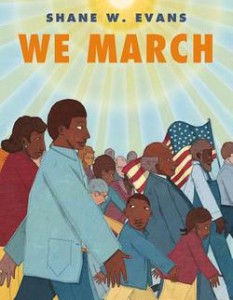 EVANS, Shane W. We March. Illus by author. Roaring Brook. 2012. $16.99. ISBN 9781596435391. Gr K-2–A minimal text and mixed-media illustrations tell the story of one family’s participation in the 1963 March on Washington for Jobs and Freedom. Monumental figures, including that of Dr. Martin Luther King Jr., striking images of the gathering crowds at Washington Monument, and stirring language imbue this event with its historical significance. Common Core Connection Kindergarten. Ask students to explain to a partner what is happening in each picture. Combine with an age appropriate biography of Martin Luther King, Jr. for a unit celebrating the civil rights leader’s birthday or Black History Month. Have children make their own protest signs for a bulletin board or a display of the classroom principles. CC.K.R.I.7
EVANS, Shane W. We March. Illus by author. Roaring Brook. 2012. $16.99. ISBN 9781596435391. Gr K-2–A minimal text and mixed-media illustrations tell the story of one family’s participation in the 1963 March on Washington for Jobs and Freedom. Monumental figures, including that of Dr. Martin Luther King Jr., striking images of the gathering crowds at Washington Monument, and stirring language imbue this event with its historical significance. Common Core Connection Kindergarten. Ask students to explain to a partner what is happening in each picture. Combine with an age appropriate biography of Martin Luther King, Jr. for a unit celebrating the civil rights leader’s birthday or Black History Month. Have children make their own protest signs for a bulletin board or a display of the classroom principles. CC.K.R.I.7 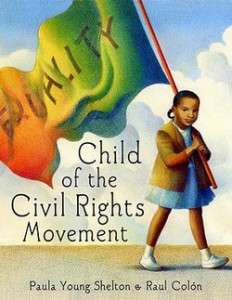 SHELTON, Paula Young. Child of the Civil Rights Movement. Illus. by Raul Colón. Random/Schwartz & Wade. 2010. $17.99. ISBN 9780375843143. Gr K-3–In brief reflections brimming with affection for her family, including “Uncle Ralph” Abernathy and “Aunt Coretta” Scott King, Andrew Young’s daughter recalls her parents’ activism and her desire to join them on a march. The story concludes at the passage of the Voting Rights Act. Colón’s luminous pencil-and-watercolor wash illustrations limb soft, textured shapes in a palette featuring a rainbow of colors. Common Core Connection Grade 2. Working in teams or pairs, have children play the “Selma to Montgomery Memory Game.” One child asks a question about the author's stories and the other child provides an answer using the text. The child/team that answer the most questions from memory wins. The prize? The first to walk to lunch, etc.! CC.2.SL.3.
SHELTON, Paula Young. Child of the Civil Rights Movement. Illus. by Raul Colón. Random/Schwartz & Wade. 2010. $17.99. ISBN 9780375843143. Gr K-3–In brief reflections brimming with affection for her family, including “Uncle Ralph” Abernathy and “Aunt Coretta” Scott King, Andrew Young’s daughter recalls her parents’ activism and her desire to join them on a march. The story concludes at the passage of the Voting Rights Act. Colón’s luminous pencil-and-watercolor wash illustrations limb soft, textured shapes in a palette featuring a rainbow of colors. Common Core Connection Grade 2. Working in teams or pairs, have children play the “Selma to Montgomery Memory Game.” One child asks a question about the author's stories and the other child provides an answer using the text. The child/team that answer the most questions from memory wins. The prize? The first to walk to lunch, etc.! CC.2.SL.3. 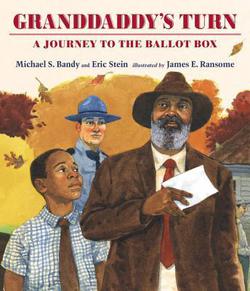 BANDY, Michael S. and Eric Stein. Granddaddy’s Turn: A Journey to the Ballot Box. Illus. James E. Ransome. Candlewick. 2015. $16.99. ISBN 9780763665937. K-Gr 3–In this bittersweet tale, a boy accompanies his beloved Granddaddy to the polling station on Election Day only to witness the man’s humiliation when he fails a bogus test. When he is old enough to vote, the young man casts his first ballot in his grandfather’s memory. Watercolor illustrations evoke a rural life and a man of perseverance and faith. Common Core Connection Grade One. Using the text and illustrations, ask children to recreate the story’s sequence of events and analyze pictures to explain the characters’ emotions at different points in the story. Discuss the concepts of patience and working for change and why they are important. Gather examples from the children’s own experiences and from current or community events as appropriate. CC.1.R.L.7 Marching On
BANDY, Michael S. and Eric Stein. Granddaddy’s Turn: A Journey to the Ballot Box. Illus. James E. Ransome. Candlewick. 2015. $16.99. ISBN 9780763665937. K-Gr 3–In this bittersweet tale, a boy accompanies his beloved Granddaddy to the polling station on Election Day only to witness the man’s humiliation when he fails a bogus test. When he is old enough to vote, the young man casts his first ballot in his grandfather’s memory. Watercolor illustrations evoke a rural life and a man of perseverance and faith. Common Core Connection Grade One. Using the text and illustrations, ask children to recreate the story’s sequence of events and analyze pictures to explain the characters’ emotions at different points in the story. Discuss the concepts of patience and working for change and why they are important. Gather examples from the children’s own experiences and from current or community events as appropriate. CC.1.R.L.7 Marching On 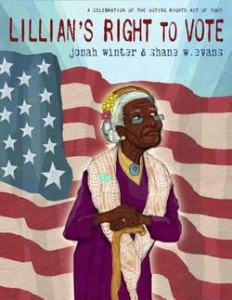 WINTER, Jonah. Lillian’s Right to Vote. Illus. by Shane W. Evans. Random/Schwartz & Wade. 2015. $17.99. ISBN 9780385390286. Gr 3-6–Lillian’s uphill walk to the polling place serves as a metaphor for the milestones in African Americans’ struggle to achieve voting rights. The journey moves from “dark time[s],” when her great-grandpa was “owned by another man,” to Selma, Alabama, where she hears “Reverend King asking how long they will have to wait for justice,” to August 6, 1965, the day President Johnson signed the Voting Rights Act. The story is based on the life of Lillian Allen, who at age 100, campaigned and voted for President Barack Obama. Mixed-media illustrations depict the woman’s journey and in warm raspberry, blue, and gold tones that reflect at various times her despair, her hope, and her perseverance. Common Core Connection Grade Three. Using the text, discuss what the right to vote means for American citizens. Ask students why they think some people don’t vote. Create digital audio recordings of children sharing their ideas about what freedom means to them. CC.3.SL
WINTER, Jonah. Lillian’s Right to Vote. Illus. by Shane W. Evans. Random/Schwartz & Wade. 2015. $17.99. ISBN 9780385390286. Gr 3-6–Lillian’s uphill walk to the polling place serves as a metaphor for the milestones in African Americans’ struggle to achieve voting rights. The journey moves from “dark time[s],” when her great-grandpa was “owned by another man,” to Selma, Alabama, where she hears “Reverend King asking how long they will have to wait for justice,” to August 6, 1965, the day President Johnson signed the Voting Rights Act. The story is based on the life of Lillian Allen, who at age 100, campaigned and voted for President Barack Obama. Mixed-media illustrations depict the woman’s journey and in warm raspberry, blue, and gold tones that reflect at various times her despair, her hope, and her perseverance. Common Core Connection Grade Three. Using the text, discuss what the right to vote means for American citizens. Ask students why they think some people don’t vote. Create digital audio recordings of children sharing their ideas about what freedom means to them. CC.3.SL 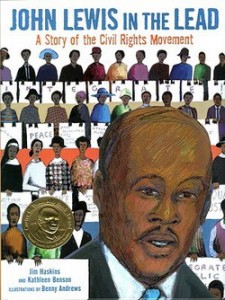 HASKINS, Jim & Kathleen Benson. John Lewis in the Lead: A Story of the Civil Rights Movement. illus. by Benny Andrews. Lee & Low. 2006. $17.95. ISBN 9781584302506. Gr 3-6–This picture book biography provides a solid introduction to the life of John Lewis, from his childhood tending chickens on an Alabama sharecropping farm to his years as a civil rights activist to his service in the United States Congress. The clear text ably strikes a balance between the subject matter and age-appropriate explanations. Folk art illustrations in oil and fabric effectively evoke both the anger directed at African American citizens and the resolve of Lewis and other freedom fighters. Common Core Connection Grade Four. Using the text, ask students to identify the goals of the civil rights movement. Do they agree or disagree with those goals? Have them state their reasons. CC.4.R.I.1, R.L.1 Common Core Connection Grade Five. Using the text and additional materials, compare John Lewis’s participation in the civil rights movement with that of Mohandas K. Gandhi in nonviolent protests in India. CC.5.R.I.1,3,7,9 Common Core Connection Grade Six. Using the text, identify milestones in the fight for civil rights. What role did John Lewis play at each of these events? Who were other important participants? What were their contributions? CC.6.R.I.3
HASKINS, Jim & Kathleen Benson. John Lewis in the Lead: A Story of the Civil Rights Movement. illus. by Benny Andrews. Lee & Low. 2006. $17.95. ISBN 9781584302506. Gr 3-6–This picture book biography provides a solid introduction to the life of John Lewis, from his childhood tending chickens on an Alabama sharecropping farm to his years as a civil rights activist to his service in the United States Congress. The clear text ably strikes a balance between the subject matter and age-appropriate explanations. Folk art illustrations in oil and fabric effectively evoke both the anger directed at African American citizens and the resolve of Lewis and other freedom fighters. Common Core Connection Grade Four. Using the text, ask students to identify the goals of the civil rights movement. Do they agree or disagree with those goals? Have them state their reasons. CC.4.R.I.1, R.L.1 Common Core Connection Grade Five. Using the text and additional materials, compare John Lewis’s participation in the civil rights movement with that of Mohandas K. Gandhi in nonviolent protests in India. CC.5.R.I.1,3,7,9 Common Core Connection Grade Six. Using the text, identify milestones in the fight for civil rights. What role did John Lewis play at each of these events? Who were other important participants? What were their contributions? CC.6.R.I.3 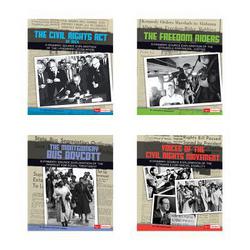 VARIOUS authors. We Shall Overcome series. (The Civil Rights Act of 1964, Freedom Riders, The Little Rock Nine, The March on Washington, The Montgomery Bus Boycott, Voices of the Civil Rights Movement). Capstone. 2014, 2015. $119.94 (series). 9781491424797 (series). Gr 4-8–Although pedagogical in tone, this series provides students with valuable primary source material. It also serves struggling middle school readers; vocabulary is defined in context, clear captions accompany photographs, and related information in sidebars serve to break up the text. Together the books weave a chronological narrative of the civil rights movement. The parallels drawn between the historical events and their present-day significance will encourage readers to view the movement from a broader perspective. Common Core Connection Grade Seven. Using background material from the text and from additional resources, have students each choose a photograph to research. Narrate the facts surrounding each photograph in a digital presentation to be shared with the class or posted online. (CC.7.R.I.3,7, CC.7.R.L.3,7,9)
VARIOUS authors. We Shall Overcome series. (The Civil Rights Act of 1964, Freedom Riders, The Little Rock Nine, The March on Washington, The Montgomery Bus Boycott, Voices of the Civil Rights Movement). Capstone. 2014, 2015. $119.94 (series). 9781491424797 (series). Gr 4-8–Although pedagogical in tone, this series provides students with valuable primary source material. It also serves struggling middle school readers; vocabulary is defined in context, clear captions accompany photographs, and related information in sidebars serve to break up the text. Together the books weave a chronological narrative of the civil rights movement. The parallels drawn between the historical events and their present-day significance will encourage readers to view the movement from a broader perspective. Common Core Connection Grade Seven. Using background material from the text and from additional resources, have students each choose a photograph to research. Narrate the facts surrounding each photograph in a digital presentation to be shared with the class or posted online. (CC.7.R.I.3,7, CC.7.R.L.3,7,9) 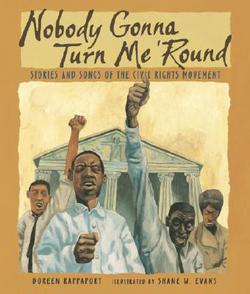 RAPPAPORT, Doreen. Nobody Gonna Turn Me 'Round: Stories and Songs of the Civil Rights Movement. Illus. by Shane W. Evans. Candlewick. 2006. $19.99. ISBN 9780763619275. Gr 5-8–In this accessible chronology of the civil rights movement from 1955 to 1965, Rappaport highlights where and when songs played an important role in protests. The clearly presented text is accompanied by dramatic oil portraits of pivotal figures and events. The content of some of the images and the language in primary source quotations make this a title for mature middle grade readers. Common Core Connection Grade Five and Up. Examine and play samples from songs sung by civil rights activists as mentioned in Rappaport’s book and Lynda Blackmon Lowery’s Turning 15 on the Road to Freedom (see below) for a multimedia tour of history. Follow up with a discussion of songs that inspire us today. CC.5.SL.5 and others. LOWERY, Lynda Blackmon, as told to Elspeth Leacock and Susan Buckley. Turning 15 on the Road to Freedom: My Story of the Selma Voting Rights March. Illus. by PJ Loughran. Dial. 2015. $19.99. ISBN 9780803741232. Gr 5 Up–Lowery’s first person narrative of her youthful activism culminates with the events of Bloody Sunday and the Selma to Montgomery March. With her teenaged innocence, idealism, and bravery in evidence, the author is able to describe the hatred and violence she witnessed in a manner that young readers can process. Generous white space, numerous inset black-and white photographs and colorful, full-page illustrations lend a hybrid look to this autobiography. Common Core Connection Grade Six. Citing the text, identify the pivotal moments in Lowery’s work for civil rights. Looking back, ask students if they think she would have done anything differently given a second chance. Argue both sides. CC.6.R.I.2, CC.6.R.L.2
RAPPAPORT, Doreen. Nobody Gonna Turn Me 'Round: Stories and Songs of the Civil Rights Movement. Illus. by Shane W. Evans. Candlewick. 2006. $19.99. ISBN 9780763619275. Gr 5-8–In this accessible chronology of the civil rights movement from 1955 to 1965, Rappaport highlights where and when songs played an important role in protests. The clearly presented text is accompanied by dramatic oil portraits of pivotal figures and events. The content of some of the images and the language in primary source quotations make this a title for mature middle grade readers. Common Core Connection Grade Five and Up. Examine and play samples from songs sung by civil rights activists as mentioned in Rappaport’s book and Lynda Blackmon Lowery’s Turning 15 on the Road to Freedom (see below) for a multimedia tour of history. Follow up with a discussion of songs that inspire us today. CC.5.SL.5 and others. LOWERY, Lynda Blackmon, as told to Elspeth Leacock and Susan Buckley. Turning 15 on the Road to Freedom: My Story of the Selma Voting Rights March. Illus. by PJ Loughran. Dial. 2015. $19.99. ISBN 9780803741232. Gr 5 Up–Lowery’s first person narrative of her youthful activism culminates with the events of Bloody Sunday and the Selma to Montgomery March. With her teenaged innocence, idealism, and bravery in evidence, the author is able to describe the hatred and violence she witnessed in a manner that young readers can process. Generous white space, numerous inset black-and white photographs and colorful, full-page illustrations lend a hybrid look to this autobiography. Common Core Connection Grade Six. Citing the text, identify the pivotal moments in Lowery’s work for civil rights. Looking back, ask students if they think she would have done anything differently given a second chance. Argue both sides. CC.6.R.I.2, CC.6.R.L.2 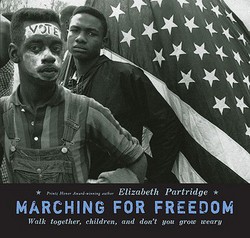 PARTRIDGE, Elizabeth. Marching for Freedom. Viking. 2009. $19.99. ISBN 9780670011896. Gr 5-10–Through interviews and the stories of participating teenagers, Partridge chronicles the events of 1963-1965 that led to the landmark Selma to Montgomery March and the Voting Rights Act of 1965. Black-and-white photographs tell their own stories of ordinary citizens interacting with sheriffs, politicians, and renowned activists. Common Core Connection Grade Eight. Using the text and other nonfiction material as background support, ask students to choose one photograph from the book (or the Library of Congress’ American Memory Collection) and write a vignette or story about an individual in the image, describing that person’s day and what brought him or her to that moment. Collect everyone’s stories in an online diary or blog. Have students create audio narrations for their stories. CC.8.SL.4,5. Going the Distance
PARTRIDGE, Elizabeth. Marching for Freedom. Viking. 2009. $19.99. ISBN 9780670011896. Gr 5-10–Through interviews and the stories of participating teenagers, Partridge chronicles the events of 1963-1965 that led to the landmark Selma to Montgomery March and the Voting Rights Act of 1965. Black-and-white photographs tell their own stories of ordinary citizens interacting with sheriffs, politicians, and renowned activists. Common Core Connection Grade Eight. Using the text and other nonfiction material as background support, ask students to choose one photograph from the book (or the Library of Congress’ American Memory Collection) and write a vignette or story about an individual in the image, describing that person’s day and what brought him or her to that moment. Collect everyone’s stories in an online diary or blog. Have students create audio narrations for their stories. CC.8.SL.4,5. Going the Distance 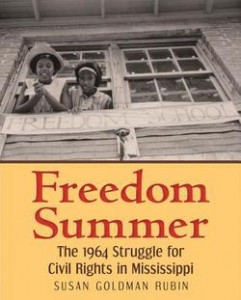 RUBIN, Susan Goldman. Freedom Summer: The 1964 Struggle for Civil Rights in Mississippi. Holiday House. 2014. $18.95. ISBN 9780823429202. Gr 7 Up–Anecdotes and interviews present the voter registration campaigns in Mississippi in 1964 in personal terms. Later events, including the Mississippi Freedom Democratic Party’s presence at the Democratic National Convention and the Voting Rights Act of 1965, are related as direct consequences of the shocking murder of three young activists (Andrew Goodman, James Chaney, Michael Schwerner) that occurred in the state. Black-and-white archival photographs and news articles and maps add texture and to this overview. Common Core Connection Grade 12. Using the text, discuss the violence directed at citizens in Mississippi in 1964 and compare it to modern examples of alleged brutality against minorities in Ferguson, Missouri, Cleveland, Ohio, and/or Baltimore, Maryland. Using contemporary print and online news sources cite similarities and differences. As you read articles, discuss the concept of bias in reporting. What point(s) of view might reporters bring to their work, and how can readers use them to accurately understand past events? CC.11-12.SL.1,1a,b,c,d L
RUBIN, Susan Goldman. Freedom Summer: The 1964 Struggle for Civil Rights in Mississippi. Holiday House. 2014. $18.95. ISBN 9780823429202. Gr 7 Up–Anecdotes and interviews present the voter registration campaigns in Mississippi in 1964 in personal terms. Later events, including the Mississippi Freedom Democratic Party’s presence at the Democratic National Convention and the Voting Rights Act of 1965, are related as direct consequences of the shocking murder of three young activists (Andrew Goodman, James Chaney, Michael Schwerner) that occurred in the state. Black-and-white archival photographs and news articles and maps add texture and to this overview. Common Core Connection Grade 12. Using the text, discuss the violence directed at citizens in Mississippi in 1964 and compare it to modern examples of alleged brutality against minorities in Ferguson, Missouri, Cleveland, Ohio, and/or Baltimore, Maryland. Using contemporary print and online news sources cite similarities and differences. As you read articles, discuss the concept of bias in reporting. What point(s) of view might reporters bring to their work, and how can readers use them to accurately understand past events? CC.11-12.SL.1,1a,b,c,d L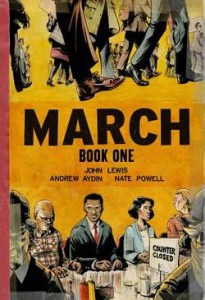 EWIS, John, Andrew Aydin & Nate Powell. March: Book One and March: Book Two. Illus by Nate Powell. Top Shelf Productions. 2013, 2015. ea. $14.95. ISBN 9781603093002, 9781603094009. Gr 9 Up–These graphic novels present a breathtaking chronicle of Congressman John Lewis’s life through flashbacks to his Alabama childhood, his years of schooling, his civil rights activism and his work in Congress. The use of shadow and light to create expansive spaces for the Southern geography, both physical and philosophical, is stunning. A compelling mix of fact and narrative, these are books that teens ask for by name. Common Core Connection Grade Nine. Discuss how Lewis uses the graphic novel format to convey biographical and historical information. Using the text, evaluate the effectiveness of the presentation. What additional information might readers wish to know after finishing March One and March Two? CC.9-10, SL.2,5.
EWIS, John, Andrew Aydin & Nate Powell. March: Book One and March: Book Two. Illus by Nate Powell. Top Shelf Productions. 2013, 2015. ea. $14.95. ISBN 9781603093002, 9781603094009. Gr 9 Up–These graphic novels present a breathtaking chronicle of Congressman John Lewis’s life through flashbacks to his Alabama childhood, his years of schooling, his civil rights activism and his work in Congress. The use of shadow and light to create expansive spaces for the Southern geography, both physical and philosophical, is stunning. A compelling mix of fact and narrative, these are books that teens ask for by name. Common Core Connection Grade Nine. Discuss how Lewis uses the graphic novel format to convey biographical and historical information. Using the text, evaluate the effectiveness of the presentation. What additional information might readers wish to know after finishing March One and March Two? CC.9-10, SL.2,5. 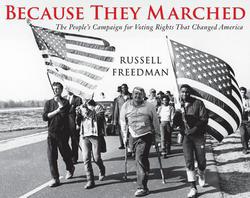 FREEDMAN, Russell. Because They Marched: The People’s Campaign for Voting Rights That Changed America. Holiday House. 2014. $20.00. ISBN 9780823429219. Gr 7 Up– Freedman provides the background to the events of the Selma voting campaign of the 1960s. He describes Martin Luther King Jr.’s role, the impact of Bloody Sunday, and the historic Selma March. He also spends some time analyzing the role the Student Nonviolent Coordinating Committee (SNCC), city leaders, and national politicians played in events. Full-page, archival black-and-white photographs illustrate the book. Common Core Connection Grade Eight. Using Freedman’s text and additional primary source material, examine the speeches of Martin Luther King, Jr., Lyndon B. Johnson, and Governor George Wallace. Identify and discuss themes and talking points. CC.8.SL.2, CC.8.W.3
FREEDMAN, Russell. Because They Marched: The People’s Campaign for Voting Rights That Changed America. Holiday House. 2014. $20.00. ISBN 9780823429219. Gr 7 Up– Freedman provides the background to the events of the Selma voting campaign of the 1960s. He describes Martin Luther King Jr.’s role, the impact of Bloody Sunday, and the historic Selma March. He also spends some time analyzing the role the Student Nonviolent Coordinating Committee (SNCC), city leaders, and national politicians played in events. Full-page, archival black-and-white photographs illustrate the book. Common Core Connection Grade Eight. Using Freedman’s text and additional primary source material, examine the speeches of Martin Luther King, Jr., Lyndon B. Johnson, and Governor George Wallace. Identify and discuss themes and talking points. CC.8.SL.2, CC.8.W.3 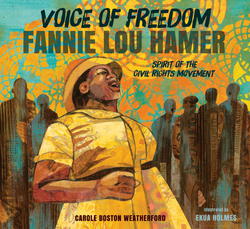 WEATHERFORD, Carole Boston. Voice of Freedom: Fannie Lou Hamer: Spirit of the Civil Rights Movement. Illus by Ekua Holmes. Candlewick, 2015. $17.99. ISBN 9780763665319, Gr 7 Up–Titled poems and reflections expose the difficult life of Fannie Lou Hamer, from her birth in 1917 to a sharecropping family in Mississippi to her adult activities to gain the vote for black citizens. Weatherford 's unflinching description of the consequences of Hamer’s bravery and her faith in her mission−including violent treatment and racist slurs−make this a book for mature readers. Holmes’s evocative collage on paper illustrations are superb. Batik stamping along with and other textures bring a sophisticated dimensionality to the work. Common Core Connection Grade 9. For many, Fannie Lou Hamer was called the “spirit” of the civil rights movement. Research and discuss civil rights activists of the 1960s or present day, having each student chose an individual to focus on from their research. Create online presentations to share with the school. Include sound or film clips when available. CC.9-10.R.I.7, SL.1.d
WEATHERFORD, Carole Boston. Voice of Freedom: Fannie Lou Hamer: Spirit of the Civil Rights Movement. Illus by Ekua Holmes. Candlewick, 2015. $17.99. ISBN 9780763665319, Gr 7 Up–Titled poems and reflections expose the difficult life of Fannie Lou Hamer, from her birth in 1917 to a sharecropping family in Mississippi to her adult activities to gain the vote for black citizens. Weatherford 's unflinching description of the consequences of Hamer’s bravery and her faith in her mission−including violent treatment and racist slurs−make this a book for mature readers. Holmes’s evocative collage on paper illustrations are superb. Batik stamping along with and other textures bring a sophisticated dimensionality to the work. Common Core Connection Grade 9. For many, Fannie Lou Hamer was called the “spirit” of the civil rights movement. Research and discuss civil rights activists of the 1960s or present day, having each student chose an individual to focus on from their research. Create online presentations to share with the school. Include sound or film clips when available. CC.9-10.R.I.7, SL.1.d  MITCHELL, Don. The Freedom Summer Murders. Scholastic, 2014. $18.99. ISBN 9780545477253. Gr 8 Up–Mitchell sheds light on the lives of three workers—James Chaney, Andrew Goodman, Michael Schwerner—murdered during the voter registration campaign of 1964. Through primary sources and searing analysis, Mitchell examines the impact of racism on civil rights and justice in the decades that followed. Common Core Connection Grade Eleven. Research the court cases related to the murders. Using primary source material as the basis for discussion, identify instances when justice may have been subverted. Use news aggregators or court databases to research current court cases with controversial verdicts. Discuss ways to ensure a transparent and unbiased criminal justice and judicial system. CC.11-12.R.I.3. HUNTER-GAULT, Charlayne. To the Mountaintop: My Journey Through the Civil Rights Movement. Roaring Brook Press, 2012. $22.99. ISBN 9781596436053. Gr 8 Up–Hunter-Gault, a journalist, and the one of the two African Americans to first desegregate the University of Georgia, uses her life experiences to chronicle civil rights history. Each chapter begins with a New York Times article on the topic, providing fascinating contrast between her personal reflections and media reports. Extensive back matter rounds out the account. Common Core Connection Grade Twelve. Compare and contrast articles from The New York Times (or other newspaper) and personal narratives (articles, biographies, Storycorp, etc.) from the same event. Note differences and similarities, focusing on tone and slant. CC.11-12.R.I.7
MITCHELL, Don. The Freedom Summer Murders. Scholastic, 2014. $18.99. ISBN 9780545477253. Gr 8 Up–Mitchell sheds light on the lives of three workers—James Chaney, Andrew Goodman, Michael Schwerner—murdered during the voter registration campaign of 1964. Through primary sources and searing analysis, Mitchell examines the impact of racism on civil rights and justice in the decades that followed. Common Core Connection Grade Eleven. Research the court cases related to the murders. Using primary source material as the basis for discussion, identify instances when justice may have been subverted. Use news aggregators or court databases to research current court cases with controversial verdicts. Discuss ways to ensure a transparent and unbiased criminal justice and judicial system. CC.11-12.R.I.3. HUNTER-GAULT, Charlayne. To the Mountaintop: My Journey Through the Civil Rights Movement. Roaring Brook Press, 2012. $22.99. ISBN 9781596436053. Gr 8 Up–Hunter-Gault, a journalist, and the one of the two African Americans to first desegregate the University of Georgia, uses her life experiences to chronicle civil rights history. Each chapter begins with a New York Times article on the topic, providing fascinating contrast between her personal reflections and media reports. Extensive back matter rounds out the account. Common Core Connection Grade Twelve. Compare and contrast articles from The New York Times (or other newspaper) and personal narratives (articles, biographies, Storycorp, etc.) from the same event. Note differences and similarities, focusing on tone and slant. CC.11-12.R.I.7 RELATED
RECOMMENDED
CAREERS
The job outlook in 2030: Librarians will be in demand
CAREERS
The job outlook in 2030: Librarians will be in demand
ALREADY A SUBSCRIBER? LOG IN
We are currently offering this content for free. Sign up now to activate your personal profile, where you can save articles for future viewing






Add Comment :-
Comment Policy:
Comment should not be empty !!!
Mr. Bobby L. Fuse, Jr.
Americus Sumter County History website. Americus Sumter County Movement Remembered Committee, Inc. see Facebook and website. Oral History Project and Digital Library of the University System of Georgia. Mr. Bobby Fuse, fusega@bellsouth.net, Americus. Georgia 229-924-0708 for further information.Posted : Aug 06, 2015 11:04